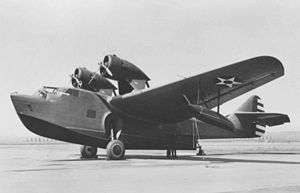Douglas YOA-5
The Douglas YOA-5 was an Amphibious aircraft designed for the United States Army Air Corps. Although a prototype was built, it did not enter production.
| YOA-5 | |
|---|---|
 | |
| Role | Seaplane bomber |
| Manufacturer | Douglas Aircraft Company |
| First flight | 1935 |
| Introduction | 1935 |
| Retired | 1943 |
| Status | Prototype |
| Primary user | United States Army Air Corps |
| Number built | 1 |
| Developed from | Douglas XP3D |
Design and development
In November 1932, the U.S. Army ordered the development of an amphibious reconnaissance aircraft/bomber, intended to act as navigation leaders and rescue aircraft for formations of conventional bombers. The resultant aircraft, which was ordered under the bomber designation YB-11, was designed in parallel with the similar but larger Douglas XP3D patrol flying boat for the United States Navy. It was a high-winged monoplane with two Wright R-1820 Cyclone radial engines mounted in individual nacelles above the wing, resembling an enlarged version of the Douglas Dolphin.[1]
Prior to completion, it was redesignated firstly as an observation aircraft YO-44 and then as the YOA-5 'observation amphibian model 5'.[2] It first flew during January 1935, and was delivered to the army during February that year.[1] The concept for which it was designed proved impracticable, and no further production ensued, but the YOA-5 was used to set two world distance records for amphibians, being finally scrapped in December 1943.[3]
Variants
- YB-11
- An amphibious reconnaissance bomber ordered in 1932 by the US Army Air Corps, powered by 2x Wright R-1820-13 Cyclone radial engines.
- YO-44
- The YB-11 redesignated in the Observation category before completion.
- YOA-5
- Another redesignation to the Observation Amphibian category. One built, given the aforementioned designations at various times in its life. The YOA-5 started life with Wright R-1820-13 Cyclone engines, was re-engined with 930 hp (690 kW) Wright YR-1820-45 Cyclone engines for experimental long-range flying, then re-engined again with 750 hp (560 kW) Wright R-1820-25 Cyclones.
Specifications (YOA-5)
Data from McDonnell Douglas aircraft since 1920 : Volume I[4]
General characteristics
- Crew: 4
- Length: 69 ft 6 in (21.18 m)
- Wingspan: 89 ft 9 in (27.36 m)
- Height: 212 ft 0 in (64.62 m)
- Gross weight: 20,000 lb (9,072 kg)
- Powerplant: 2 × Wright R-1820-25 Cyclone 9-cylinder air-cooled radial piston engines, 750 hp (560 kW) each
Performance
- Maximum speed: 169 mph (272 km/h, 147 kn) at sea level
- Power/mass: 0.075 hp/lb (0.123 kW/kg)
Armament
- Guns: 3× .30 in (7.62 mm) machine guns in open bow and fuselage positions
See also
Related lists
References
- Francillon 1979, p.192.
- Wagner, Ray, American Combat Planes, 1981, Doubleday & Company, Garden City, New York, ISBN 9780385131209, page 307
- Francillon 1979, pp. 192–193.
- Francillon, René J. (1988). McDonnell Douglas aircraft since 1920 : Volume I. London: Naval Institute Press. pp. 184–193. ISBN 0870214284.
Bibliography
- Francillon, René. McDonnell Douglas Aircraft since 1920. London:Putnam, 1979. ISBN 0-370-00050-1.
External links
| Wikimedia Commons has media related to Douglas YB-11. |